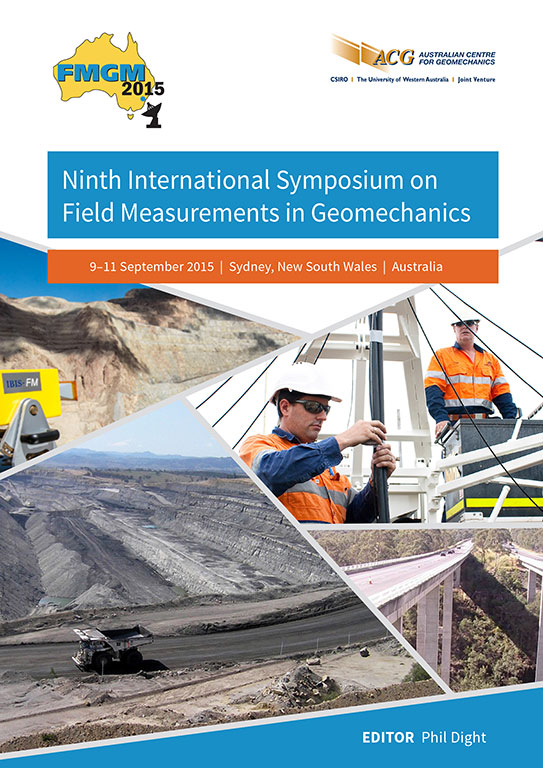Experience of using the ANZI strain cell for stress change monitoring

|
Authors: Mills, KW; Selmo, D; Todd, JB; Puller, JW; Nemcik, JA; Simonovski, Z |
DOI https://doi.org/10.36487/ACG_rep/1508_41_Mills
Cite As:
Mills, KW, Selmo, D, Todd, JB, Puller, JW, Nemcik, JA & Simonovski, Z 2015, 'Experience of using the ANZI strain cell for stress change monitoring', in PM Dight (ed.), FMGM 2015: Proceedings of the Ninth Symposium on Field Measurements in Geomechanics, Australian Centre for Geomechanics, Perth, pp. 589-600, https://doi.org/10.36487/ACG_rep/1508_41_Mills
Abstract:
This paper describes the ANZI (Australia New Zealand Inflatable) strain cell and some examples of its application for stress change monitoring. The instrument has been used over the past three decades to measure three-dimensional in situ stresses using the overcoring method of stress relief and monitor three-dimensional stress changes in a range of applications mainly associated with underground coal mining, but also with civil and metalliferous mining projects. The ANZI strain cell has a pressuremeter design that allows 18 electrical resistance strain gauges at various orientations to be pressure bonded directly to the rock on a borehole wall. The instrument’s soft polyurethane membrane and hollow pressuremeter design have characteristics that facilitate deployment, enhance data gathering, and simplify analysis. Further recent developments that improve deployment and monitoring have increased the capability of the instrument. Automatic, remote, and high speed monitoring at resolutions of just a few microstrain has significantly improved the capability to measure and thereby understand the nature of changes in the three-dimensional stress in rock strata around excavations in rock.
References:
Duncan-Fama, ME & Pender, MJ 1980, ‘Analysis of the hollow inclusion technique for measuring in situ rock stress’, International Journal of Rock Mechanics and Mining Sciences, vol. 17, pp. 137-146.
Gray, WM & Toews, NA 1974, ‘Optimisation of the design and use of a triaxial strain cell for stress determination’, Field Testing and Instrumentation of Rock, STP 554, American Society for Testing and Materials, Philadelphia, pp. 116-134.
Laier, JE, Schmertmann, JH & Schaub, JH 1975, ‘Effect of finite pressuremeter length in dry sand’, Proceedings of the ASCE Speciality Conference on In Situ Measurement of Soil Properties, American Society of Civil Engineers, Raleigh,North Carolina, USA, vol. 1, pp. 241-259.
Leeman, ER & Hayes, DJ 1966, ‘A technique for determining the complete state of stress in rock using a single borehole’, Proceedings of the 1st Congress of the International Society of Rock Mechanics, Laboratório Nacional de Engenharia Civil, Lisbon, vol. 2, pp. 17-24.
Mills, KW 1997, ‘In situ stress measurement using the ANZI stress cell’, in K Sugawara & Y Obara (eds), Proceedings of the International Symposium on Rock Stress, 7-10 October 1997, Kumamoto, Japan, A.A. Balkema, Rotterdam.
Mills, KW & Jeffrey, RG 2004, ‘Remote high resolution stress change monitoring for hydraulic fractures’, in A Karzulovic & MA Alfaro (eds), Proceedings of MassMin 2004, Instituto de Ingenieros de Chile, Santiago, pp. 529-534.
Mills, KW & Pender, MJ 1986, ‘A soft inclusion instrument for in situ stress measurement in coal’, Proceedings of the International Symposium on Rock Stress and Rock Stress Measurement, Centek Publishers, Luleå, pp. 247-251.
Mills, KW, Jeffrey, RG & Zhang, X 2004, ‘Growth analysis and fracture mechanics based on measured stress change near a full-size hydraulic fracture’, in Gulf Rocks 2004: Rock Mechanics Across Borders & Disciplines, Proceedings of the 6th North American Rock Mechanics Symposium, American Rock Mechanics Association, Houston.
© Copyright 2025, Australian Centre for Geomechanics (ACG), The University of Western Australia. All rights reserved.
View copyright/legal information
Please direct any queries or error reports to repository-acg@uwa.edu.au
View copyright/legal information
Please direct any queries or error reports to repository-acg@uwa.edu.au